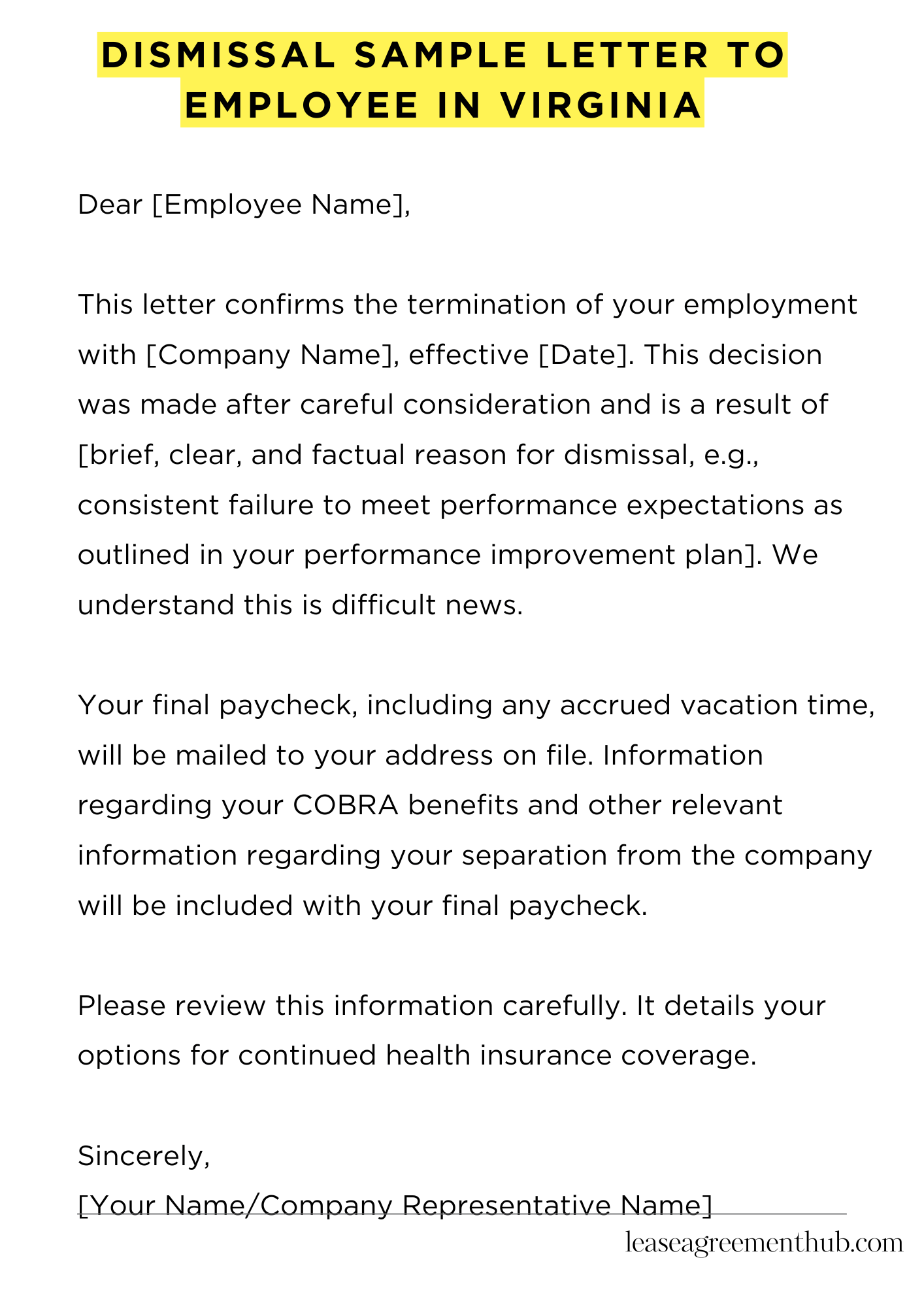A dismissal letter in Virginia officially ends an employee’s job. It explains the reasons for termination. It’s a legal document.
This article gives you sample dismissal letters. These are templates. They’re examples for Virginia employers.
Use these samples to create your own letter. They make writing easier. They help you avoid legal problems.
Dismissal Sample Letter to Employee in Virginia
[Your Company Letterhead]
[Date]
[Employee Name]
[Employee Address]
Dear [Employee Name],
This letter confirms the termination of your employment with [Company Name], effective [Date]. This decision was made after careful consideration and is a result of [brief, clear, and factual reason for dismissal, e.g., consistent failure to meet performance expectations as outlined in your performance improvement plan]. We understand this is difficult news.
Your final paycheck, including any accrued vacation time, will be mailed to your address on file. Information regarding your COBRA benefits and other relevant information regarding your separation from the company will be included with your final paycheck. Please review this information carefully. It details your options for continued health insurance coverage.
We wish you the best in your future endeavors. Please contact [HR contact person] at [phone number] or [email address] if you have any questions regarding your final pay, benefits, or other separation-related matters.
Sincerely,
[Your Name/Company Representative Name]

How to Write a Dismissal Sample Letter to Employee in Virginia
Understanding Virginia’s Employment Laws: A Crucial First Step
Before drafting any dismissal letter, thoroughly familiarize yourself with Virginia’s employment laws. Ignoring these statutes can lead to costly legal ramifications. This includes understanding at-will employment, exceptions to at-will employment, and potential claims of wrongful termination. Consult legal counsel if you’re unsure about any aspect of the legal landscape.
Defining the Reason for Dismissal: Clarity is Paramount
Vagueness is your enemy. State the reason for termination clearly and concisely. Avoid ambiguous phrasing. Specific examples of misconduct or performance deficiencies, documented beforehand, should be cited. Remember, a well-articulated rationale is your best defense against potential litigation. This is not the time for euphemisms or circumlocution.
Structuring Your Dismissal Letter: A Template for Success
A properly structured letter conveys professionalism and seriousness. Begin with a formal salutation, addressing the employee by their full name. Clearly state the purpose of the letter – the termination of employment. Then, concisely reiterate the reasons for dismissal, referencing prior warnings or performance reviews if applicable. Finally, conclude with pertinent information regarding final pay, benefits, and return of company property.
Crafting the Language: Precision and Professionalism
Use formal and professional language throughout. Avoid accusatory or inflammatory tones. Maintain a neutral and objective perspective. Employ precise wording to avoid misinterpretations. Legal jargon should be avoided unless absolutely necessary, and any technical terms should be explained clearly. The goal is to convey the information factually and dispassionately.
Key Information to Include: Navigating the Details
The letter must include the employee’s full name, their last day of employment, their final paycheck details (including any accrued vacation time pay), information about the return of company property (laptops, keys, etc.), and contact information for HR or relevant personnel regarding their benefits. Ensure all dates and figures are accurate. This attention to detail is crucial for avoiding further complications.
Review and Revision: A Prudent Precaution
Before sending the letter, carefully review it for any errors or ambiguities. Have a colleague or legal professional review it as well. Ensure the language is clear, concise, and legally sound. A well-crafted letter minimizes the risk of future disputes. This final check can prevent costly mistakes. Don’t rush this vital step.
Post-Dismissal Procedures: Maintaining Compliance
Following the delivery of the letter, adhere strictly to Virginia’s unemployment compensation laws and any other applicable regulations. Maintain meticulous records of all correspondence and communications related to the termination. Consult legal counsel if necessary to ensure full compliance with all relevant employment laws. Proactive measures now minimize future liabilities.
FAQs about dismissal sample letter to employee in Virginia
What are the essential elements of a legally sound dismissal letter in Virginia?
A legally sound dismissal letter in Virginia should clearly state the employee’s termination date, the reason for dismissal (being specific but avoiding defamatory language), and confirm whether the termination is with or without cause. It should also outline any final pay, benefits, and return of company property. Finally, it should acknowledge receipt of the letter by requiring a signature.
Can I use a generic dismissal sample letter template for Virginia?
While generic templates can provide a starting point, it’s crucial to adapt them to the specific circumstances of the employee’s termination. Using a generic letter without tailoring it to the individual situation can increase the risk of legal challenges. Consult with legal counsel to ensure compliance with Virginia employment laws.
What are the potential legal ramifications of a poorly written dismissal letter?
A poorly written dismissal letter can lead to lawsuits for wrongful termination, breach of contract, or defamation. Ambiguous wording, inaccurate information, or a lack of clarity regarding the reasons for dismissal can significantly weaken an employer’s defense against such claims. Legal costs and potential settlements can be substantial.
Should I provide a reason for dismissal in the letter?
While not always legally required, providing a clear and concise reason for dismissal is generally recommended. This helps avoid misunderstandings and potential legal challenges. However, the reason should be factual and avoid potentially defamatory statements. It’s advisable to consult with legal counsel to determine the appropriate level of detail.
What should I do if the employee refuses to sign the dismissal letter?
If the employee refuses to sign the letter, document this refusal in writing. Include the date and method of delivery (e.g., certified mail, return receipt requested). This documentation serves as proof that the employee was notified of their termination, even if they did not acknowledge receipt in writing. Maintain a copy of the letter and any related documentation.
Related: